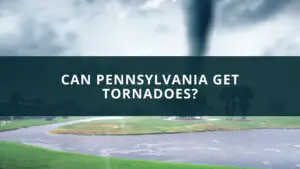The commonwealth of Pennsylvania is one of the biggest states by population in the US. It’s an iconic state with several cultural and historic places in it. If you’re planning to visit, you’ll want to know its weather conditions. So, does it snow in Pennsylvania?
It snows in Pennsylvania. The state has a humid continental climate with around 38 inches of snowfall annually. It also gets around 43 inches of rainfall. Weather hazards here include thunderstorms, tornados, and flooding. If you’re thinking of visiting, the best time is between May and October.
Despite the wet and cold weather, there are many amazing places to visit in the state. These include Philadelphia, Gettysburg, Bushkill Falls, etc. Here, we discuss whether it snows in Pennsylvania, the weather conditions, and when to visit.
Quick navigation
Pennsylvania Climate
Pennsylvania has a humid continental climate with cold winters and hot and humid summers. It has the Köppen climate classification Dfa in most parts. However, the climate differs slightly across some parts. Due to its diverse topography, it has a humid subtropical climate in the southeast corner. Known as the Keystone State, Pennsylvania is a mid-Atlantic and northeastern state with a topography including mountains, rivers, lakes, coastal plains, high plains, and rival valleys.
The state is split into two by the Appalachian Mountains. The western part is colder and receives more rain and snow than the Eastern part of the state. In its northwest is Lake Erie, its largest body of water with 51 miles of coastal shoreline. Although it doesn’t have a border with the Atlantic Ocean, it shares 57 miles of coastline with the Delaware estuary.
Temperature in Pennsylvania
During the summer, temperatures in the state range between 75°F (23.9°C) and 95°F (35°C) during the day. However, at night, it drops to between 55°F (12.8°C) and 70°F (21.1°C). In the winter, the temperature ranges from 33°F (0.6°C) to 45°F (7.2°C) at its highs. But the low range is between 19°F (-7.2°C) and 30°F (-1.1°C).
July is the hottest month here as the temperature can reach as high as 100°F (37.8°C), although such occasions are rare. On the other end, January is the coldest month, with the temperature dropping below 0°F (-17.8°C). Fog is also common during the winter here.
Rainfall in Pennsylvania
The state receives a high amount of rainfall during most seasons. The risk of flooding here is usually very high during spring, and that’s because of the high amounts of precipitation that the state gets. Pennsylvania gets ample rainfall throughout the year. The average sunny days here are 180 annually. So, there’s a good chance of cloudy skies and heavy rainfall here.
Precipitation is evenly distributed throughout the year, with July receiving peak rainfall. The average rainfall annually here is 42 inches (1067mm). The Eastern valleys near the mountains get less rainfall and have warmer temperatures throughout the year.
Snowfall in Pennsylvania
Pennsylvania receives a significant amount of snowfall every winter. The western part of the state, especially the area around Lake Erie, gets up to 100 inches (2540mm) of snowfall. February is the snowiest month of the year. The state gets an average of 38 inches of snowfall annually.
Weather Hazards in Pennsylvania
If you’re planning to move to Pennsylvania or even visit, it helps to know the hazards you should be aware of. They include:
1. Thunderstorms
The state is vulnerable to thunderstorms during springs and summers. This is most likely to happen in the highlands and mountains. So, make sure you protect yourself. Many people underestimate thunderstorms. But they can cause lightning. While this might not be the deadliest hazard, the fatality rate of about 10% is high and enough reason for you to find a hiding place.
2. Tornadoes and other Storms
Pennsylvania is also a tornado-prone state. Maybe not at the same level as Texas and Ohio, but it’s still an issue. Tornadoes are common here throughout the year until August. It gets an average of 30 tornadoes annually. Along with that, there are also tropical cyclones. These usually happen in the summer, but they rarely create landfalls. You can also experience snowstorms during the winter. Only a few reach high intensity.
3. Flooding
Pennsylvania is a very wet state, and that usually means flooding. Many parts of the state are prone to flooding, especially during March and April. So, it’s best to avoid visiting during this period.
When Should You Visit Pennsylvania?
If you’re planning a trip to the state, the best time to go would be anytime but winter. Summers here can be hot and humid, but the days are rarely too hot. Springs are warm and wet, especially between March and April, so those might not be a great time to go. But fall here is beautiful, with the temperature being mostly mild. So, if you want to visit, it’s best to go between May and October. However, you may have to consider the summer crowd as this is the peak tourist season.
It’s advisable to avoid going to the state anytime between December and February. The weather will be extremely cold and the roads icy and slippery. Snowstorms often happen in the winter and can lead to several activities being suspended. It also causes traffic as roads might be closed off. Unless you have some winter activities you want to do, the best time to leave here as a tourist is in November.
Places to Visit in Pennsylvania
Pennsylvania is an amazing state for tourism. While it might not have the sunny weather of California or the sandy white beaches of Hawaii, there are still many attractions here. They include:
1. Philadelphia
The city of Philadelphia has many references in pop culture. But a visit here will show you more to know about it. Known as the city of brotherly love, it contains the Philadelphia Museum of Art and National Historic Park, among other sights.
2. Gettysburg
Another historic site here is Gettysburg. They fought the Battle of Gettysburg. Visitors can get a comprehensive intro to civil war history at the Gettysburg Heritage Center.
3. Bushkill Falls
This scenic waterfall is one of the most beautiful spots in the state. It’s within the Pocono Mountains and consists of 8 waterfalls. There are bridges and hiking trails to access it.
4. Ricketts Glen State Park
Here’s another amazing site for nature lovers in the state. It contains 24 major waterfalls, among other amazing sights. You can hike, walk down trails, go birdwatching, and do other nature activities here.
5. Erie
The city near Lake Erie contains the only Port in the state. In addition, you can visit the Erie Maritime Museum, tour the USS Niagara, and visit the Presque Isle State Park.
In Conclusion
Pennsylvania is cold and humid, but the summers are quite pleasant. So, this is the best time to visit the state. There are several things you can do while here, from exploring Philly to checking out the site of the Battle of Gettysburg.



